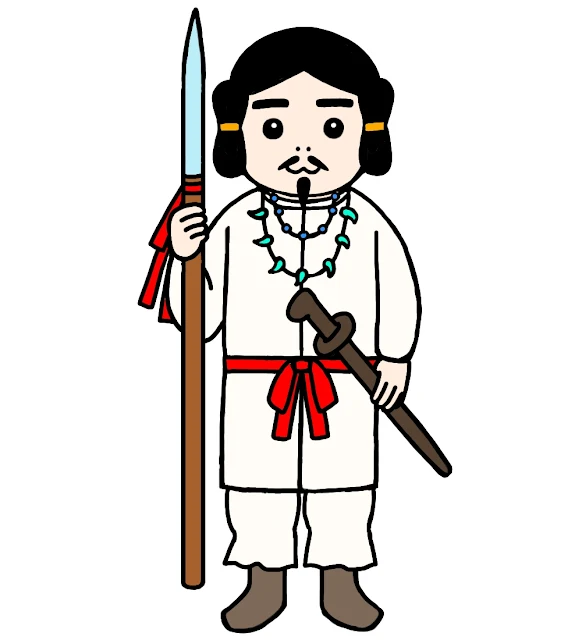
Izanagi: The Divine Creator of Japan and His Enduring Legacy
In Japanese mythology, Izanagi stands as a towering figure.
Revered as a primordial god and the creator of the Japanese islands, his story intertwines with the birth of countless deities and the very foundation of the Japanese world.
Chronicled in the ancient texts, the Kojiki and Nihon Shoki, Izanagi's tale unfolds with creation, marriage, tragedy, and ultimately, the birth of the sun goddess, Amaterasu.
{tocify} $title={Table of Contents}
The Birth of Izanagi and the Creation of the First Land
Emerging during the creation of the heavens and earth, Izanagi wasn't alone.
He appeared alongside his counterpart, Izanami, making them the seventh divine couple.
Tasked with a monumental mission – to solidify the swirling mass of the ocean and form the land – they stood upon the floating bridge of heaven, Ame-no-ukihashi.
Armed with the Ame-no-nuboko, a heavenly spear, they churned the primeval waters.
As the spear churned, a curdled mass emerged, solidifying into the first island – Onogoro Island.
This marked the beginning of the Japanese archipelago.
The Union of Izanagi and Izanami: A Procession of Creation
With the first island established, Izanagi and Izanami embarked on a new chapter: marriage.
This divine union signified the start of a grand creation myth.
Their procreation birthed a multitude of deities, each embodying a vital aspect of the world.
From the major islands of Honshu, Shikoku, and Kyushu to elemental gods representing fire, water, wind, and mountains, their offspring encompassed the diverse tapestry of nature.
A Descent into Darkness: The Death of Izanami
Tragedy struck amidst the joy of creation.
During the birth of the fire god Kagutsuchi, Izanami suffered fatal burns.
Grief-stricken, Izanagi embarked on a desperate quest to retrieve his beloved wife from the underworld, Yomi, a realm of death and darkness.
A Perilous Journey to Yomi and the Birth of New Deities
The descent into Yomi was fraught with danger.
Izanami, however, warned him not to look upon her in her state of decay.
Consumed by curiosity and desperate longing, Izanagi ignited a torch, revealing a horrifying sight – Izanami's decomposed form.
Repelled by the sight, Izanagi fled, sealing the entrance to Yomi with a giant boulder.
Despite the failed rescue attempt, Izanagi's story wasn't over.
As he emerged from the underworld, he underwent a vigorous purification ritual to cleanse himself of the defilement of the death realm.
From the various parts of his body emerged three of the most significant deities in Japanese mythology:
- Amaterasu: The radiant sun goddess, born from Izanagi's left eye, became the ruler of the heavens and the ancestress of the Japanese imperial family. Her radiance and warmth symbolized life and growth.
- Tsukuyomi: The moon god, emerged from Izanagi's right eye, and became the ruler of the night. His contrasting role to Amaterasu established the natural cycle of day and night.
- Susanoo: The tempestuous god of storms and the sea emerged from Izanagi's nose. Known for his wild and destructive nature, he also possessed the power of creation and fertility.
Izanagi's Retreat and the Enduring Legacy of a Creator God
Following these events, Izanagi retreated to the secluded realm of Takamagahara, also known as the "Palace of the Hidden Sun."
This became his sanctuary, where he observed the affairs of the divine world.
Though secluded, his legacy as the progenitor of the gods and the shaper of the Japanese world remained.
The Worship of Izanagi: A Legacy Remembered
Across Japan, shrines dedicated to Izanagi stand as testaments to his enduring importance.
The Izanagi Shrine in Izumo is a prime example, attracting pilgrims seeking blessings for fertility, marriage, and strong foundations.
The rituals and ceremonies performed at these shrines honor Izanagi and express gratitude for his role in shaping the world.
Izanagi's story resonates beyond the narrative of creation.
Some interpretations view Izanagi and Izanami's act of creating land as a metaphor for the volcanic activity and tectonic shifts that shaped Japan's physical geography.
His descent into Yomi, the underworld, can also be seen as a symbolic journey into the depths of human emotions, grappling with loss and the enduring power of love.
Izanagi's Legacy in Japanese Culture
Izanagi's influence extends far beyond religious practices.
He is a cultural touchstone, appearing in various forms of artistic expression:
- Art: Depictions of Izanagi and Izanami's creation myth are found in traditional Japanese paintings, woodblock prints, and sculptures. These artworks often capture the grandeur of creation, the tragedy of Izanami's death, and the determination of Izanagi's journey.
- Theatre: Noh, a classical Japanese drama form, features a play based on the Izanagi-Izanami myth. These plays explore themes of life, death, creation, and the power of the divine.
- Literature: Izanagi's story continues to inspire writers and poets. He appears in various literary works, from ancient myths to contemporary novels, serving as a symbol of creation, perseverance, and the complexities of human emotions.
Beyond Artistic Expression
- Lineage and Identity: The Japanese imperial family traces its lineage back to Amaterasu, the sun goddess born from Izanagi. This connection to the divine realm through Izanagi reinforces the legitimacy and authority of the emperor.
- Concepts of Purity and Pollution: Izanagi's purification ritual after returning from Yomi highlights the importance of purity in Shinto beliefs. It underscores the separation between the realms of the living and the dead, and the need for cleansing after contact with death.
Izanagi's enduring legacy lies in his role as the foundational figure in Japanese mythology.
He represents the power of creation, the cycle of life and death, and the connection between the natural world and the divine realm.
His story continues to shape Japanese culture, inspiring artistic expression, reinforcing cultural identity, and offering insights into the human condition.

Post a Comment